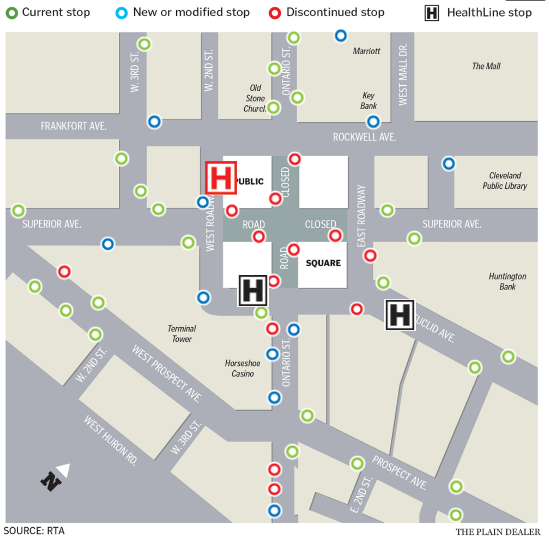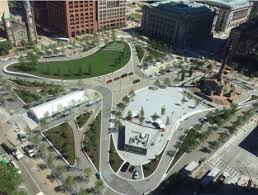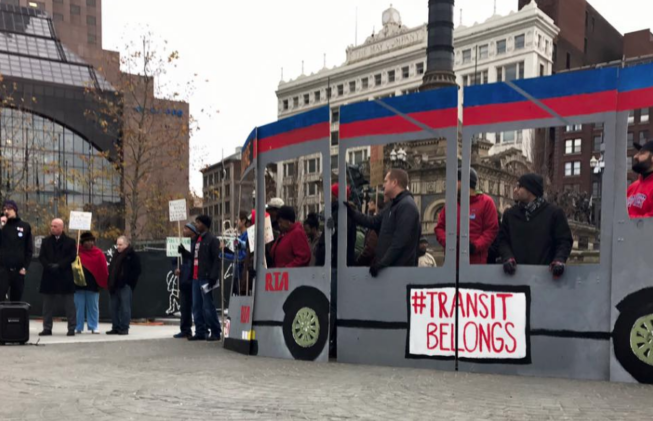Transit riders in Cleveland can't get a break.
Last year, Greater Cleveland RTA, facing a budget crisis, was forced to raise fares and cut service. Each trip now costs $2.50 -- no transfer included -- an 11 percent hike, and riders are getting worse service for their dollar. Thanks to a state decision exempting some healthcare spending from sales tax, the RTA is again facing a large shortfall this year.
Piling on to these problems is Cleveland Mayor Frank Jackson, who decided to reroute buses around the city's Public Square last month, undoing an earlier deal intended to protect transit riders. The square is the hub of the region's bus system.
Public Square was recently redesigned by starchitect James Corner (of High Line fame) at a cost of $50 million. The project was intended to bolster Cleveland's image for out-of-town visitors ahead of the Republican National Convention. It called for closing two cross streets -- Ontario and Superior -- to car traffic in order to establish a contiguous four-block public space in the center of downtown. One of those streets, Superior, was supposed to remain open to buses.
Up until the redesign, bus passengers made 20,000 transfers inside Public Square each day. The routing offered convenient access to both the hub of the city's rail system (across the street in Terminal Tower) and the Healthline BRT, just outside the square. Public Square primarily served working class people waiting for buses and making connections.
Booting buses off Ontario and Superior would require the rerouting of nearly every bus route in the RTA system and cost the agency an additional $2.6 million in annual operating expenses, according to a Nelson/Nygaard study commissioned by the city prior to the redesign.
So, as a compromise, city leaders had agreed to allow buses on Superior, cutting the additional annual expense to about $1 million. Corner designed the square to include a plaza-like pass-through for RTA buses on Superior. But Jackson's announcement last month scrapped that arrangement.

The square has remained off limits to buses since its official reopening August, while the Jackson said the city was studying the impacts to transit riders. But it's not clear how much actual studying they did.
RTA riders testified last week that their trips have been delayed as much as 10 minutes due to additional congestion and extra turns to get around the square. City officials estimate the delays more conservatively: about two minutes. But even two minutes per rider is a substantial drag for the most heavily-used part of the bus system.

City Hall officials testified at a hearing last week that buses in the square may endanger people since there are new features like a in-ground fountain where children play. They also claimed that buses in the square would somehow pose a terrorist threat.
Routing buses around the square creates its own dangers, however. RTA officials say the closure will force buses to make 1 million additional turns each year, and each turn increases the risk to people walking on the perimeter of the square. Just today, an elderly pedestrian was seriously injured outside the square by a turning bus driver.
In addition to the time and money lost to the rerouting of buses, RTA may be fined $12 million by the Federal Transit Administration as a result of Jackson's decision. The money was part of the grant the agency received for the Healthline. In August, FTA threatened to withdraw the $12 million if the square was closed to buses, saying the money had been awarded based on an agreement that the Healthline would terminate in a "downtown transit zone" with dedicated bus lanes.
The Jackson administration doesn't seem to be very concerned, however. At last week's hearing, the mayor's chief of staff Ken Silliman said the city "will cross that bridge when they come to it" and also that repayment would be RTA's responsibility. RTA and city officials say they will work on a plan to use dedicated transit lanes and signal timing to minimize delays.
Meanwhile, some local elected officials have called out the bus reroute as discriminatory. Council Member Zach Reed testified at the hearing that "suburbanites" don't want "certain people to come and be on Public Square." He proceeded to read comments from Cleveland.com calling transit riders "low-lifes" and "degenerates." Transit advocates including All Aboard Ohio are exploring whether the city's unilateral decision to route buses off the square -- which did not include a public process -- might run afoul of environmental laws.
The public had never been invited to weigh in on the new bus routing until the City Council convened a special hearing last week. All members of the mayor's staff promptly walked out as the public comment portion began.
Seats where Jackson administration officials were sitting before public hearing portion started are now vacated. pic.twitter.com/RFSRCXC2AU
— Ginger Christ (@GChristCLE) November 30, 2016
Chris Stocking, a transit commuter who helps coordinate Clevelanders for Public Transit, a local advocacy group, said he's been timing the delays and they're typically about five to seven minutes each way.
"Just closing this small stretch of road is making this really complicated," he said. "You wouldn’t really think it’s that big of a deal but it’s a pretty big deal."
Now Stocking says he has to exit his bus in a more dangerous location by a taxi stand and walk several blocks across the square to make his connection.
"It’s tight when your bus is already late and you have to run a few minutes around tower city to make a connection," he said. "That five- or seven-minute delay might cause you to miss your connecting bus, and those buses might only come every 30 minutes or an hour."






